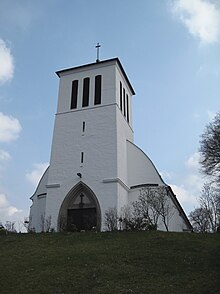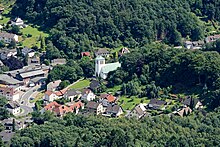St. Petrus Canisius (Hemer)
St. Petrus Canisius is one of five Roman Catholic parish churches in the city of Hemer . The building from 1931 got its characteristic white color in the 1950s and is located on a hill in the western district of Wiehagen . The community is in the deanery Märkisches Sauerland .
history
From planning to consecration
After the construction of a chapel in 1872, the neighboring town of Sundwig was also responsible for the Western Catholics, who from then on went to worship there and in the successor building of St. Bonifatius and no longer in St. Peter and Paul in Niederhemer . With its own Catholic school, Westig took the first step towards becoming an independent community in 1908. The first plans to build a church in Westig had already been made in the previous years.
On March 7, 1909, a church building association was finally founded, which by 1913 had collected around 40,000 RM. With these funds, the community had a precise plan for the construction of the church drawn up, which, however, could not be implemented directly due to a change in the pastor's office. As a result of the First World War and inflation in the following years, the church building association lost its credit and began collecting again.
On April 20, 1927, Westig became a parish vicarie , which in addition to Westig itself also included Frönsberg . In 1929 a few more collections were made for a church building, which enabled the groundbreaking ceremony on August 11, 1930. The construction was largely taken from the drafts of the prewar years. The nave should be 25 meters long and 14 meters wide, so that the church, including the tower and choir, should accommodate 700 people. The tower was over 18.35 meters high and was increased to almost 22 meters in 1954.
The excavation of the site was completed in September and the foundation stone was laid on December 14, 1930 during a ceremony. The consecration took place on October 4, 1931 and was originally intended to be carried out by Paderborn Auxiliary Bishop Johannes Hillebrand . Due to his sudden death a few days earlier, the Iserlohn dean was given permission to consecrate the church. Saint Peter Canisius was chosen as the namesake . The last work was finally completed by Christmas.
Nazi regime and the post-war period
On April 26, 1936, the consecration of the church by Auxiliary Bishop Augustinus Philipp Baumann took place. A few years later the neighboring Catholic school had to close and was merged with the Protestant school to form a single school. Fines were imposed on the then parish vicar Karl Kewes. Just like his successor, Kewes designed the interior of the church artistically.
After the Westiger community had previously needed the financial help of the Sundwiger Bonifatiusverein , it received its own asset management and its own church council in 1941. At the same time, however, police repression increased. The parish library opened in 1938 was confiscated and the vicar was brought to Dortmund for interrogation.
After the war, the Catholic elementary school was reopened in 1947. On April 1, 1948, the parish of Sundwig finally took place . The church had already been renovated beforehand. The building was redesigned in 1946 with new church windows, a baptismal font , chandeliers and a way of the cross . Artist Walter Klocke had already started many of the works before the war and was able to complete them after 1945. In 1948 the congregation received a new tabernacle and two years later an organ . In 1954 the white plaster was applied, which together with the exposed location on a hill contributed to the fact that the church became a landmark of Westig. Four new bells were purchased and consecrated at the end of the year.
Major renovations took place in 1962 when the roof and exterior plaster were replaced. A year later the sexton's house was torn down and replaced by a new rectory in 1965. In 1969 the Catholic school was combined with the Protestant denominational school to form a community elementary school that still exists today.
Renovations and remodeling
In 1975 the decision was made to completely renovate the church. Two years later the planning was completed and the fundraising began, among other things in the form of a parish festival. Work began on February 6, 1978, in the course of which the cellar that was still in existence was given up. Painting work fundamentally changed the interior of the church and the insulation of the side walls was intended to reduce the moisture in the masonry. On July 1, 1978 the first service took place again in the parish church, on August 12 the neo-Gothic altarpiece was consecrated.
On March 24, 1980 the foundation stone was laid for a new rectory, which was inaugurated on December 14. In 1997 the 400th birthday of the church patron Petrus Canisius was celebrated in the form of a traveling exhibition in the parish hall. In 2001, the building is subject to renovation work in which the rectory and rectory were connected to one another.
Furnishing
Bells
The parish chronicle reports about the first bell: “As soon as the lamellar roof was erected and the roof turret put on, a little bell was given.” The bell founder is unknown. The founder is not named in the chronicle. In the meantime it has been found out that the bell comes from Oestrich. The local church “Maria Himmelfahrt” got a bell in 1930. So the little bell, striking tone b ″, came to Westig, where it still hangs in the roof turret today. After the Second World War, a chime made of cast steel bells was ordered from the Bochum Association . On November 27, 1954, four bells were delivered by the Bochum Association. On November 28, 1954, Dean Meckel from Letmathe made the solemn consecration of the bells. The bells rang for the first time at Christmas 1954. It is the largest and heaviest chime in the Hemer urban area. The tower had to be raised by three meters to accommodate the large bells. The following table provides an overview of the bells:
| inscription | Chime | diameter | Weight |
|---|---|---|---|
| “AVE REGINA COELORUM. Donated by Bernhard Stübbecke " |
c ' | 168 cm | 2230 kg |
| "St. JOSEPH COSTODI NOS. Dedicated to the fallen " |
it' | 142 cm | 1340 kg |
| "ST. PETRE CANISI + ORA PRO NOBIS. Your namesake + the congregation " |
f ' | 126 cm | 950 kg |
| "ST. BERNARDES + SIC NOBIS LUMEN. Donated by Pastor Bernhard Limper " |
G' | 112 cm | 680 kg |
organ
The church, built in 1930/31, was given an organ in 1950 , after the services had been accompanied musically by a harmonium. The work of the Paderborn company Anton Feith has 17 registers with 1125 pipes and a pneumatic action. In 1978, the organ of the organ builder was Brothers Stockmann overhauled from Werl and keeping the disposition and the cone chest to electrical play and key action rebuilt. As a result, the organ got a new console. A case was made for the previously free-standing pipework, which had previously been omitted for financial reasons.
|
|
|
||||||||||||||||||||||||||||||||||||||||||
See also
literature
- Mieders, Georg: St. Petrus Canisius Hemer-Westig 60 years in: Der Schlüssel , Hemer 1991.
Web links
Individual evidence
- ↑ Festschrift 75 years of St. Petrus Canisius Hemer-Westig (PDF; 714 kB)
- ↑ Werner Hoffmann: The Primer. Volume 6: Churches, bells, organs in the Hemer urban area. Zimmermann-Verlag, Balve 2001. pp. 147-152
Coordinates: 51 ° 22 ′ 19.7 ″ N , 7 ° 45 ′ 0 ″ E


